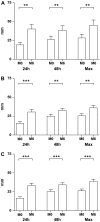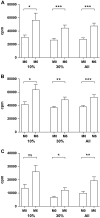Calorie restriction enhances T-cell-mediated immune response in adult overweight men and women
- PMID: 19638417
- PMCID: PMC2759570
- DOI: 10.1093/gerona/glp101
Calorie restriction enhances T-cell-mediated immune response in adult overweight men and women
Abstract
Calorie restriction (CR) enhances immune response and prolongs life span in animals. However, information on the applicability of these results to humans is limited. T-cell function declines with age. We examined effects of CR on T-cell function in humans. Forty-six overweight, nonobese participants aged 20-42 years were randomly assigned to 30% or 10% CR group for 6 months. Delayed-type hypersensitivity (DTH), T-cell proliferation (TP), and prostaglandin E(2) (PGE(2)) productions were determined before and after CR. DTH and TP to T-cell mitogens were increased in both groups over baseline (p < or = .019). However, number of positive responses to DTH antigens (p = .016) and TP to anti-CD3 reached statistical significance only after 30% CR (p = .001). Lipopolysaccharide-stimulated PGE(2) was reduced in both groups but reached statistical significance after 30% CR (p < or = .029). These results, for the first time, show that 6-month CR in humans improves T-cell function.
Figures




Similar articles
-
Calorie restriction-induced leptin reduction and T-lymphocyte activation in blood and adipose tissue in men with overweight and obesity.Int J Obes (Lond). 2024 Jul;48(7):993-1002. doi: 10.1038/s41366-024-01513-7. Epub 2024 Mar 27. Int J Obes (Lond). 2024. PMID: 38538853 Free PMC article.
-
Effect of 6-month caloric restriction on Cu bound to ceruloplasmin in adult overweight subjects.J Nutr Biochem. 2015 Aug;26(8):876-82. doi: 10.1016/j.jnutbio.2015.03.012. Epub 2015 May 6. J Nutr Biochem. 2015. PMID: 26001545 Free PMC article. Clinical Trial.
-
Effect of 6-month calorie restriction on biomarkers of longevity, metabolic adaptation, and oxidative stress in overweight individuals: a randomized controlled trial.JAMA. 2006 Apr 5;295(13):1539-48. doi: 10.1001/jama.295.13.1539. JAMA. 2006. PMID: 16595757 Free PMC article. Clinical Trial.
-
Regulation of delayed type hypersensitivity to host histocompatibility antigens during graft-versus-host reactions.Immunol Rev. 1985 Dec;88:25-57. doi: 10.1111/j.1600-065x.1985.tb01152.x. Immunol Rev. 1985. PMID: 2935486 Review.
-
Regulation of the immune response by prostaglandins.J Clin Immunol. 1983 Oct;3(4):295-315. doi: 10.1007/BF00915791. J Clin Immunol. 1983. PMID: 6140268 Review.
Cited by
-
Metabolic checkpoints in activated T cells.Nat Immunol. 2012 Oct;13(10):907-15. doi: 10.1038/ni.2386. Epub 2012 Sep 18. Nat Immunol. 2012. PMID: 22990888 Review.
-
"Cell Membrane Theory of Senescence" and the Role of Bioactive Lipids in Aging, and Aging Associated Diseases and Their Therapeutic Implications.Biomolecules. 2021 Feb 8;11(2):241. doi: 10.3390/biom11020241. Biomolecules. 2021. PMID: 33567774 Free PMC article. Review.
-
Fasting and calorie restriction modulate age-associated immunosenescence and inflammaging.Aging Med (Milton). 2024 Aug 12;7(4):499-509. doi: 10.1002/agm2.12342. eCollection 2024 Aug. Aging Med (Milton). 2024. PMID: 39234195 Free PMC article. Review.
-
The role of nutrition in enhancing immunity in aging.Aging Dis. 2012 Feb;3(1):91-129. Epub 2011 Sep 30. Aging Dis. 2012. PMID: 22500273 Free PMC article.
-
Healthy ageing: the natural consequences of good nutrition-a conference report.Eur J Nutr. 2018 Jun;57(Suppl 2):15-34. doi: 10.1007/s00394-018-1723-0. Eur J Nutr. 2018. PMID: 29799073 Free PMC article.
References
-
- Weindruch R, Walford RL, Fligiel S, et al. The retardation of aging in mice by dietary restriction: longevity, cancer, immunity and lifetime energy intake. J Nutr. 1986;116(4):641–654. - PubMed
-
- Cohn JR, Hohl CA, Buckley CE., III The relationship between cutaneous cellular immune responsiveness and mortality in a nursing home population. J Am Geriatr Soc. 1983;31(12):808–809. - PubMed
-
- Roberts-Thomson IC, Whittingham S, Youngchaiyud U, et al. Ageing, immune response, and mortality. Lancet. 1974;2(7877):368–370. - PubMed
-
- Rodysill KJ, Hansen L, O’Leary JJ. Cutaneous-delayed hypersensitivity in nursing home and geriatric clinic patients. Implications for the tuberculin test. J Am Geriatr Soc. 1989;37(5):435–443. - PubMed
Publication types
MeSH terms
Substances
Grants and funding
LinkOut - more resources
Full Text Sources
Other Literature Sources

